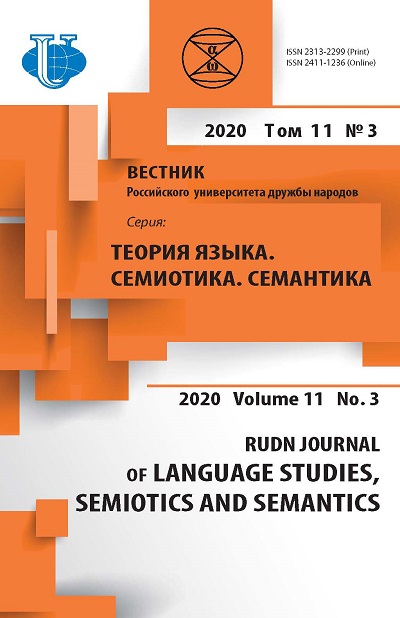Typical Grammatical Peculiarities of Formal and Business Writing in the Russian and Swedish Languages
- Authors: Matytsina I.V.1
-
Affiliations:
- Lomonosov Moscow State University
- Issue: Vol 11, No 3 (2020)
- Pages: 572-584
- Section: FUNCTIONAL GRAMMAR
- URL: https://journals.rudn.ru/semiotics-semantics/article/view/24607
- DOI: https://doi.org/10.22363/2313-2299-2020-11-3-572-584
- ID: 24607
Cite item
Full Text
Abstract
The article deals with comparative analysis of the Russian-Swedish parallel texts of the Convention between the Government of the Russian Federation and the Government of the Kingdom of Sweden about mutual assistance in the fight against the violation of the tax legislation (Avtal mellan konungariket Sveriges regering och Ryska federationens regering om ömsesidigt bistånd vid bekämpning av vissa fiskala brott). The Swedish and Russian texts differ immensely in their lexical and grammatical structure. The reason for these discrepancies is rooted, firstly, in typological distinctions between Russian and Swedish as languages of different groups and, secondly, in those processes of conscious simplification and regulation that the Swedish Language of formal business communication have been affected by during the last fifty years particularly in relation to clear language policy (klarspråk). In spite of some innovations the Russian Language of formal business communication in many ways continues to be traditional enough. The article is focused on a narrow range of issues relating to differences in grammatical structure of a sentence and prevailing nominal structures in the Russian text as compared with the verb oriented Swedish one. The juxtaposition of parallel texts and further systematization of differences between the Russian and Swedish Languages of formal and business communication makes it possible to give a comparative characteristic of this functional style existing in Russia and Sweden. The research is carried out by means of the continuous sampling method using the method of linguistic description to characterize utterance structure in grammar. Research results can be used in courses on a comparative typology of Russian and Swedish, stylistics, the theory and practice of translation.
About the authors
Irina V. Matytsina
Lomonosov Moscow State University
Author for correspondence.
Email: imatits@gmail.com
PhD in Philology, Associate Professor of the German and Celtic philology Facultу
1, Leninskie gory, Moscow, Russian Federation, 119991References
- Wellander, E. (1966). Hur bör våra myndigheters språk utvecklas — tidsenligt eller stilenligt? Svensk Juristtidning. Arg. 51 (4). рр. 241—295. (In Svedish).
- Wellander, E. (1967). Styrd språkutveckling. Svensk Juristtidning. Arg. 52 (9), 617—629. (In Svedish).
- The Federal Law On the State Language of the Russian Federation. 01.06.2005. § 4. (In Russ.).
- Mustajoki, A. (2013). Varieties of Russian: Analysis and Classification. Problems of Linguistics, 3—27. (In Russ.).
- Krongaus, M. (2017). Russian Language on the Verge of a Nervous Breakdown. М.: Corpus. (In Russ.).
- Mesenyashina, L.A. (1996). Russian Language for Business Communication. Chelyabinsk: Chelyabinsk State University. (In Russ.).
- Convention between the Government of the Russian Federation and the Government of the Kingdom of Sweden about mutual assistance in the fight against the violation of the tax legislation. URL: http://docs.cntd.ru/document/901722918 (accessed: 07.04.2020).
- Avtal mellan konungariket Sveriges regering och Ryska federationens regering om ömsesidigt bistånd vid bekämpning av vissa fiskala brott. URL: https://www.regeringen.se/49c82b/ contentassets/2bce335acc484b549b3f606b23553b18/avtal-med-ryska-federationen-om-samarbete-inom-halsa-och-sociala-fragor (accessed: 07.04.2020). (In Svedish).
- Sokolova, S.V. (2007). Dynamic Processes in the System of Pronominal Words in Modern Russian: PhD in Philology. URL: https://www.dissercat.com/content/dinamicheskie-protsessy-v-sisteme-mestoimennykh-slov-sovremennogo-russkogo-yazyka (accessed: 07.04.2020). (In Russ.).
- Maslova-Lashanskya, S.S. (1995). Swedish Language Textbook. Saint Petersburg: Petro-RIF. (In Russ).
- Valgina, N.S. Theory of the Text. Moscow: Logos. (In Russ.).
- Rodoman, N.V. (2009). English for Master’s Students. A Course on Political Translation: Lexical Aspect. Moscow: MGIMO. (In Russ.).
- Myndigheternas skrivregler URL: https://www.regeringen.se/49b6d1/contentassets/ 5b473488ef174cff9d6dc405f9da6f1b/myndigheternas-skrivregler.
- Timofeyeva, S.V. The System of Ontological Modal Meanings//Electronic scientific & practical journal Humanities Scientific Researches. URL: http://human.snauka.ru/2015/03/9427. (accessed: 07.04.2020). (In Russ.).
- Vinogradov, V.V. The Russian Language. URL: http://slovari.ru/default.aspx?s=0&p=5310&0a0=2 (accessed: 07.04.2020). (In Russ.).
- Matytsina, I.V. (2019). Transformations as the Main Means of Code Switching. Uchenye Zapiski Kazanskogo Universiteta. Seriya Gumanitarnye Nauki. Proceedings of Kazan University. Humanities Series, 161 (5—6), 147—157. (In Russ.).
- Ehrenberg-Sundin, B. (1999). Klarspråksarbetet i Sverige, Klart språk i Norden. [Электронный ресурс]. URL: http://ojs.statsbiblioteket.dk/index.php/ksn/article/viewFile/ 18303/15960 (accessed: 20.06.19). (In Svedish).
- Svarta listan — ord och fraser som kan ersättas i författningsspråk. PM 2011:1. URL: https://www.regeringen.se/rapporter/2011/10/pm-20111/ (accessed: 20.06.19). (In Svedish).
- Hedlund, А. (2013). Klarspråk lönar sig: handbok för ett effektivt klarspråksarbete. Stockholm: Norstedts juridik. (In Svedish).
- Bendegard, S. Klarspråksarbetets villkor i samband med EU:s rättsaktsöversättning. URL: https://journals.uio.no/ (accessed: 08.04.20). (In Svedish).
- Ny förvaltningslag. Betänkande av förvaltningsrättsutredningen//SOU 1983:73. URL: http://regina.kb.se/sou/ (accessed: 20.06.19). (In Svedish).
- Några riktlinjer för författningsspråket//Statsrådsberedningen PM 1994:4, rev. 1998.06.30. URL: https://www.regeringen.se/rapporter/1999/06/pm-19944/ (accessed: 20.06.19). (In Svedish).
- Mål i mun. Förslag till handlingsprogram för svenska språket//SOU 2002:27. URL: http://regina.kb.se/sou/ (accessed: 20.06.19). (In Svedish).
- Matytsina, I.V. (2003). Trends in the Linguistic Development since 1945. The Swedish Language Today and Tomorrow In The Proceedings of the International Conference to Commemorate the 100th Anniversary of Prof. M.I. Stebli-Kamensky’s Birth. Saint-Peterburg: Nauka. pр. 150—162. (In Russ.).
- Tchekalina, E.M. (2019). The Linguistic Situation and Language Policy in Modern Sweden. Vestnik Moskovskogo Universiteta. 9. Philology, 6, 9—22. (In Russ.).
- Bergman, G. (1970). Kortfattad svensk språkhistoria. Stockholm: Prisma. (In Svedish).
- Wellander, E. Kommittésvenska — en undersökning och ett försök till riktlinjer // SOU 1950:26. URL: http://regina.kb.se/sou/ (accessed: 20.06.19). (In Svedish).
- Moberg, L. (2005). Svenskt och tyskt i det medeltida Stockholm. Svenskan i tusen år, red. Moberg L., Westman M. Stockholm: Norstedts Akademiska förlag. pp. 31—50.
- Matytsina, I.V. (2016). The Emergence and Development of the Officialese in Sweden (Based on Swedish Studies). Synchrony. Dyachrony. Textology. Festschrift in Honor of Professor Elena Tchekalina’s Anniversary. Moscow: MAKS Press. pр. 224—233. (In Russ.).
- Matytsina, I.V. (2016). The Language of the Law and Documents from the 14th to 18th Centuries. Vestnik Tverskogo gosudarstvennogo universiteta. Philology, 2, 25—33. (In Russ.).
Supplementary files












